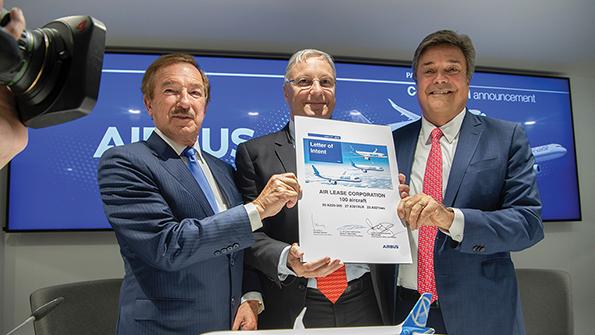過去の好業績の副作用に苦しむ、航空機リース会社

航空機リースは1970年代から航空業界で注目を浴びるようになり、AerCap、GECAS・Air Lease Corp.(ALC)、Avalonといった大企業が生まれた。各社の好調ぶりは安全資産を求めていた投資家の目に止まり、潤沢な国際資本を背景に多くの新規参入を招いた。多くの機材を保有するリース会社の数は数年で2倍になった。
ピーク時期である2017年には、ボーイング社に対する直接発注の30%をリース会社が占めていたが、これ以降は減少している。OEMに発注することに加え、定期的に多数の機材を航空会社からリースバックで購入し、それを相互に売買する形を取っている。
エアバス社やボーイング社にとってリース会社は魅力的な販売チャンネルであり、ライオンエアーやインディゴといった低価格航空会社(LCC)の成長と並び業績の拡大につながってきた。
投資家にとっても、航空機は魅力的な資産に映る。他の多くの資産と異なり、資産配置に失敗したとしても世界中に動かすことができるからだ。その確かな魅力が資金を呼び入れたが、今では必ずしも利益を生み出せているとは限らない。
過去の好業績が多くの新規参入を招いた結果、業界は厳しい状況に陥りつつある。大手リース会社の経営陣の多くが、今は調整の時期だと語るようになった。航空機リースのコンセプトは行き着くところまで行ってしまったのだろうか?
「この業界では、リースのシェアが30%以下ならリース会社は好調になり、40%以上では厳しくなると言われている。過去数年で多くの新規参入があり、現在は供給過多だ」。こう語るのはBOCアビエーション社のIR責任者、Timothy Ross氏だ。「10年前は6~8社しかなかったが、今では2倍になっている」とも付け加えた。
AerCap社のCEO、Aengus Kelly氏は航空機リースが注目を集めすぎたことにより、業界内に「不適格者」が殺到する事態を招いたと主張する。「経験の浅いリース会社は、運航に不可欠な内装を期限までに発注する、といった基本的なリースの仕組みすら理解していないことが多い」と述べている。航空会社の発注を巡って多くのリース会社が競合する中で、新参のリース会社があまりに早い段階で安値を提示し、マーケットを破壊する事例が多発している。
「航空会社は信じられないほど魅力的なリースバックの提案を受けている」と語るのはAVALON社のCEO、Domhnal Slattery氏だ。もちろん、これはボーイング737MAX運航停止前の話だ。マーケットから同機が消え、運航再開の目処が立たない中では、どんなリース案件もまず契約までは至らないからだ。一方、エアバスA320neoを発注しているリース会社といえども、737MAXの運航停止はそれほどの追い風にはなっていない。なぜなら、短期的に投入できる機体はあったとしてもごく僅かであり、そこにエアバス社の生産遅延も重なっているからだ。
この状況は新型コロナウィルス(COVID-19)の流行により、さらに複雑化している。多くのリース会社がアジア太平洋地域における減便で余剰となった機体を、737MAX運航停止による機材不足に陥った航空会社に振り向ける動きを加速させているからだ。ALC社やAerCap社のように強固な財務基盤を持つリース会社は、状況によってはリース料金の支払期限を延長することで、航空会社の負担を軽くする対応も取っている。
平常時であっても、大手リース会社は大手同士で競合することを望んでいる。ロス氏はこう語る「成熟した会社との競合はまだいい方だ。経験の浅いリース会社はすぐパニックを起こしがちで、真っ先に価格の話を始める」。しかしリース契約には返却条件や為替ヘッジなど、他にも重要な項目がある。ここに挙げた2つだけでも複雑な提案の組み立てが必要だが、多くの新規参入者にはそれができない。
以上は、Jens FlottauがAviation Week & Space Technologyに書いた記事の簡略版です。業界がいかに「不適格者に救われたか」、そして航空機リースに関するその他の問題については、フルバージョンの記事をご覧ください。全文を英語でご覧いただくには、ログインまたは購読していただく必要があります。
Lessors have been around for a long time. The concept began to gain traction in air transport in the 1970s. Since that time, true powerhouses such as AerCap, GECAS, Air Lease Corp. (ALC) and Avolon have emerged. Their success has attracted more investors and money to the industry, with an abundance of available global capital seeking seemingly secure homes. The number of lessors with large portfolios of aircraft has doubled in a few years.
Lessors placed about 30% of direct Boeing orders at their peak in 2017, but the number has since declined. In addition to placing orders with the OEMs, lessors routinely buy large portfolios of aircraft in sale-and-leaseback deals with airlines, then trade those portfolios with each other.
Lessors have proven to be an attractive sales channel for Airbus and Boeing, driving growth alongside emerging low-cost carriers such as Lion Air and IndiGo.
For investors, aircraft seem to be really attractive assets. Unlike many other assets, they can be moved around worldwide if a placement proves unsuccessful. That perceived attractiveness has pulled in money, though not always smart money.
But the leasing sector is increasingly becoming the victim of its own success. A growing number of its leaders are saying it is time for an adjustment. Has the leasing concept gone too far?
There are some basic numbers on which the industry agrees: “Lessors make good money if the leasing share is below 30%; it becomes difficult above 40%,” says Timothy Ross, BOC Aviation’s head of investor relations. “We are in an oversupply situation,” he says, due to many new lessors having aggressively entered the market over the last few years. “There were 6-8 lessors 10 years ago. Now there are twice that number,” he adds.
AerCap CEO Aengus Kelly says overexposure to the lessor channel has led to an influx of “incompetence” in the market. “[Aircraft manufacturers] have given the product to incompetent players,” he contends. Inexperienced lessors are often unaware of the intricacies of even preparing for entry into service, such as ordering interiors on time, he notes. With too many lessors competing for airline deals, the small new players will often offer bargain rates too soon and destroy the market for everyone else.
“Airlines have been getting unbelievably attractive sale-and-leaseback deals,” says Avolon CEO Domhnal Slattery. Of course, this was before the Boeing 737 MAX grounding. Since the aircraft is temporarily off the market, it is all but impossible to agree on any type of lease deals because its return-to-service timing is still unclear. At the same time, lessors with A320neo orders have been unable to benefit much from the grounding because they have few, if any, aircraft available to place in the short term—and Airbus production delays are not helping.
The situation is made even more complex by the recent COVID-19 outbreak that has left many lessors scrambling to place surplus aircraft from Asia-Pacific fleets with customers in other regions desperate for backup capacity available to fill gaps created by the MAX grounding. Financially strong lessors such as ALC or AerCap are sometimes prepared to assist airline customers by allowing them to temporarily defer lease payments.
Even in normal times. the major players would prefer to face only each other. “Competing against grown-ups is better,” Ross says. “Inexperienced lessors tend to panic quickly and talk about price first.” But there are many other levers in lease contracts that are important, too—return conditions and currency hedges being just two that require the complex deal structuring of which many new players are simply incapable.